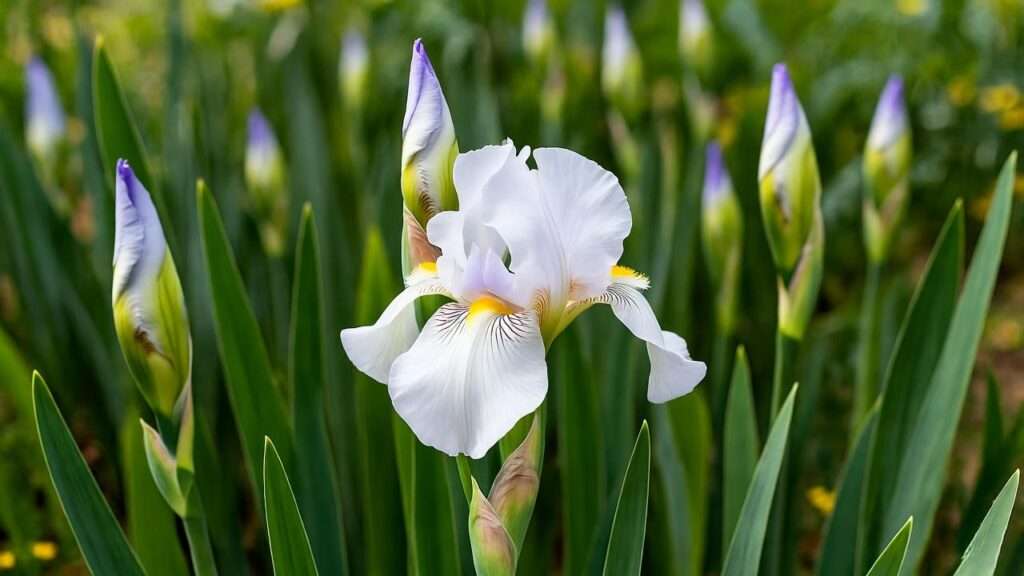Imagine a garden where delicate white iris plants sway gracefully, their pure petals glowing under the sun, transforming your backyard into a serene oasis. The white iris plant, with its elegant blooms and timeless charm, is a favorite among gardeners seeking low-maintenance beauty. Whether you’re a novice or a seasoned horticulturist, growing these stunning perennials is easier than you think with the right guidance. In this comprehensive guide, we’ll unlock the secrets to cultivating vibrant white iris plants, ensuring they thrive in your garden. Drawing on years of hands-on experience and insights from the American Iris Society, this article provides everything you need to grow, care for, and showcase these floral gems. From planting tips to pest control, let’s dive into creating a breathtaking display of white irises! 🌷
1. Understanding the White Iris Plant 🌿
1.1 What Is a White Iris Plant? 🌼
The white iris plant (Iris spp.) is a perennial known for its striking, fan-shaped blooms and sword-like foliage. Belonging to the Iridaceae family, these plants are celebrated for their elegance and versatility. Popular varieties include the bearded Iris germanica ‘Immortality’, with its ruffled white petals, and the Siberian Iris sibirica ‘White Swirl’, known for its delicate, graceful blooms. Historically, irises have symbolized purity and wisdom, appearing in ancient art and mythology, from Greek goddesses to Renaissance paintings. Their ability to thrive in diverse climates (USDA zones 3–9) makes them a go-to choice for ornamental gardens.
1.2 Benefits of Growing White Irises 🌸
White irises are more than just a pretty face. Their crisp blooms add sophistication to any landscape, whether in formal borders or naturalistic settings. They’re relatively low-maintenance compared to other perennials, requiring minimal care once established. These plants are also versatile, fitting seamlessly into garden beds, borders, or even near water features for Siberian varieties. Ecologically, white irises attract pollinators like bees and butterflies, supporting local biodiversity. Plus, their rhizomatous roots help stabilize soil, making them a practical and beautiful addition to your garden.
1.3 Common Challenges and Solutions 🌱
While white irises are hardy, they can face challenges like root rot, iris borers, or improper planting. Overwatering or poor drainage often leads to rhizome rot, while pests like borers can damage foliage and roots. Don’t worry—this guide will equip you with expert solutions to prevent and address these issues, ensuring your irises flourish. By following our research-backed tips, you’ll overcome obstacles and enjoy vibrant blooms year after year.
2. Choosing the Right White Iris Variety 🌷
2.1 Popular White Iris Varieties 🥰
Selecting the perfect white iris variety sets the stage for a thriving garden. Here are three standout options:
- Bearded Iris ‘Immortality’: Known for its large, ruffled white petals and sweet fragrance, this variety often reblooms in late summer. It’s drought-tolerant and ideal for sunny, well-drained spots.
- Siberian Iris ‘White Swirl’: With slender, elegant blooms, this variety thrives in moist soils, making it perfect for rain gardens or near ponds.
- Dutch Iris ‘White Excelsior’: Compact and ideal for cut flowers, this variety offers bright white blooms with yellow accents, suited for smaller spaces.
Table: White Iris Variety Comparison
| Variety | Bloom Time | Height | Hardiness Zones | Soil Preference |
|---|---|---|---|---|
| Immortality | Spring, Rebloom | 30–36 in | 4–9 | Well-drained |
| White Swirl | Late Spring | 24–30 in | 3–8 | Moist, Well-drained |
| White Excelsior | Early Summer | 18–24 in | 5–9 | Well-drained |
2.2 Factors to Consider When Choosing 🌞
Your climate, soil type, and garden goals influence which white iris variety is best. Most irises thrive in USDA zones 3–9, but check your local zone for compatibility. Bearded irises prefer well-drained, slightly acidic to neutral soil (pH 6.5–7), while Siberian irises tolerate wetter conditions. Consider your aesthetic vision—formal gardens may favor bearded irises, while naturalistic designs suit Siberian varieties. Expert Tip: Visit a local nursery or consult the American Iris Society for region-specific recommendations to ensure success.
3. Planting Your White Iris Plant 🌱
3.1 When to Plant White Irises ⏰
Timing is critical for healthy white iris plants. The ideal planting window is late summer to early fall (August–September) in most regions, allowing rhizomes to establish before winter dormancy. In warmer climates (zones 8–9), early spring planting can work, but avoid extreme heat to prevent stress. Proper timing ensures strong root development and vibrant blooms the following season.
3.2 Where to Plant 🌍
White irises need the right environment to shine. Choose a spot with full sun (at least 6 hours daily) to promote robust blooms. Well-drained soil is essential for bearded and Dutch irises, while Siberian irises tolerate moist conditions. Space plants 12–18 inches apart to prevent overcrowding and reduce disease risk. Avoid planting near trees or shrubs that compete for water and nutrients. Pro Tip: Test soil drainage by digging a hole, filling it with water, and ensuring it drains within a few hours.
3.3 Step-by-Step Planting Guide 🚀
- Prepare the Soil: Loosen soil to a depth of 12 inches and mix in compost or aged manure for nutrients.
- Plant Rhizomes: Dig a shallow hole, placing bearded iris rhizomes just below the surface with roots spread downward. For Siberian or Dutch irises, plant bulbs 3–4 inches deep.
- Position Correctly: Ensure bearded iris rhizomes are partially exposed to prevent rot. Orient the fan of leaves outward for aesthetic growth.
- Water Thoroughly: Water immediately after planting to settle the soil, but avoid waterlogging.
- Mulch Lightly: Apply a thin layer of mulch to retain moisture, avoiding direct contact with rhizomes.
Visual Idea: A diagram showing proper rhizome planting depth can clarify this step for beginners.
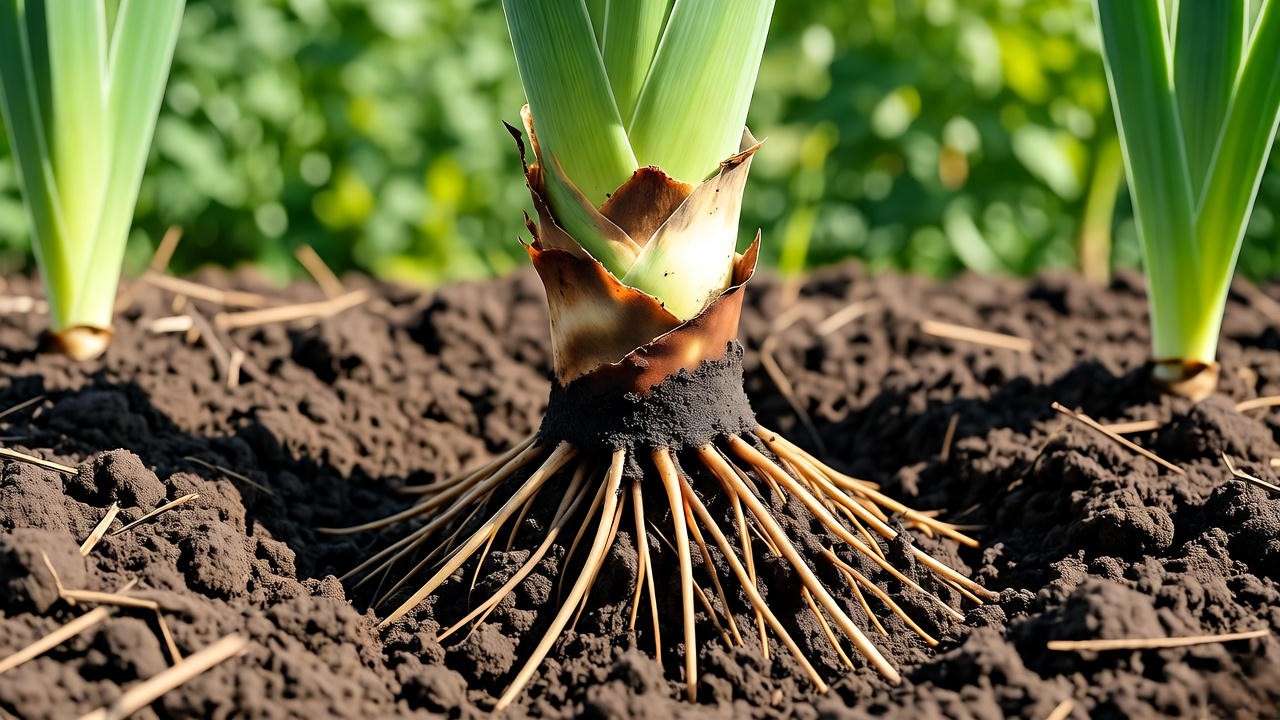
4. Caring for Your White Iris Plant 🌿
4.1 Watering Needs 💧
White irises require moderate watering, especially during their first growing season. Water deeply once a week, ensuring the soil stays moist but not soggy. Established plants are drought-tolerant, needing less frequent watering. Siberian irises prefer consistently moist soil, especially in spring. Watch for signs of overwatering (yellowing leaves, soft rhizomes) or underwatering (wilting, dry foliage). Adjust based on rainfall and soil drainage to keep plants healthy.
4.2 Fertilizing for Vibrant Blooms 🌸
Fertilizing enhances bloom quality but requires care. Use a low-nitrogen, high-phosphorus fertilizer (e.g., 5-10-10) to promote flowering over foliage growth. Apply in early spring as new growth emerges and again after blooming to support next year’s flowers. Organic options like compost tea or bone meal work well for eco-conscious gardeners. Expert Insight: Over-fertilizing with nitrogen can lead to lush leaves but fewer blooms, so stick to balanced formulas.
4.3 Pruning and Deadheading ✂️
Regular pruning keeps white irises tidy and healthy. Deadhead spent blooms by cutting flower stalks at the base to encourage reblooming in varieties like ‘Immortality’. Trim damaged or yellowing leaves throughout the season. In late fall, cut foliage back to 6 inches to prepare for dormancy and reduce disease risk. Pro Tip: Sterilize pruning tools with alcohol to prevent spreading pathogens.
4.4 Dividing and Transplanting 🌱
Dividing white irises every 3–5 years prevents overcrowding and maintains vigor. The best time is late summer, after blooming but before dormancy. Dig up the rhizome clump, separate healthy sections with at least one fan of leaves, and trim roots to 4–6 inches. Replant immediately, following the planting guide above. Pro Tip: Discard soft or discolored rhizomes to prevent disease spread.
5. Protecting Your White Iris from Pests and Diseases 🐛
5.1 Common Pests 🐞
White irises face threats from iris borers, aphids, and slugs. Iris borers, the most destructive, tunnel into rhizomes, causing rot. Inspect plants regularly, removing affected leaves and larvae. Aphids can distort foliage; control them with neem oil or insecticidal soap. Slugs, common in moist conditions, can be deterred with diatomaceous earth or hand-picking at night. Expert Tip: Encourage beneficial insects like ladybugs to naturally reduce aphid populations.
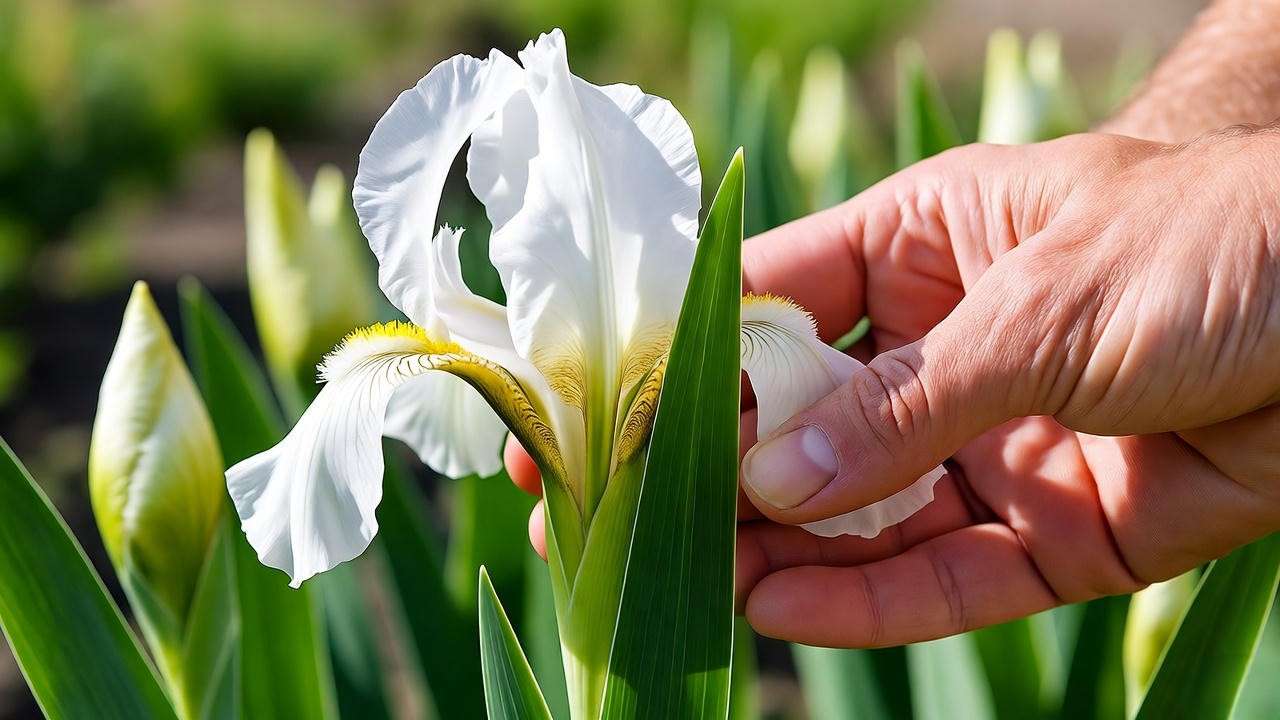
5.2 Common Diseases 🦠
Root rot, leaf spot, and bacterial soft rot are common issues. Root rot, often caused by overwatering or poor drainage, can be prevented by ensuring well-drained soil. Leaf spot appears as brown patches on foliage; remove affected leaves and avoid overhead watering. Bacterial soft rot, marked by foul-smelling rhizomes, requires removing and destroying infected parts. Case Study: A gardener in Ohio revived a white iris bed by improving drainage with raised beds and applying organic fungicides, restoring vibrant blooms within a season.
6. Seasonal Care for White Irises 🍂
6.1 Spring Care 🌷
Spring is the season of renewal for your white iris plants, as they emerge from dormancy with fresh growth. Start by removing winter mulch to allow sunlight to warm the soil. Apply a low-nitrogen fertilizer (e.g., 5-10-10) to encourage blooming. Inspect for early signs of pests, like iris borer eggs, which appear as tiny reddish-brown spots on leaves. Gently clean debris from the base of plants to prevent fungal issues. Water moderately, ensuring soil remains moist but not waterlogged, especially for newly planted irises. Pro Tip: Check soil pH in spring, aiming for 6.5–7, and amend with lime if too acidic.
6.2 Summer Care ☀️
Summer is when white irises shine with their stunning blooms. Continue deadheading spent flowers to promote reblooming in varieties like ‘Immortality’ and maintain a tidy appearance. Water consistently, especially during dry spells, but avoid overwatering bearded irises, which prefer drier conditions post-bloom. Monitor for heat stress, indicated by wilting or browning leaf tips, and provide afternoon shade in hotter climates if needed. Mulch lightly with organic material like bark to retain moisture and suppress weeds. Expert Insight: Regular inspections during summer can catch pest issues early, preventing damage to rhizomes.
6.3 Fall and Winter Care ❄️
As fall arrives, prepare your white iris plants for dormancy to ensure they return stronger next season. After the first frost, cut back foliage to 6 inches to reduce disease risk and deter pests. In colder zones (3–5), apply a 2–3 inch layer of straw or evergreen boughs over rhizomes to protect against freezing temperatures, but avoid heavy mulch that traps moisture. For Siberian irises, ensure soil remains slightly moist through fall. In milder climates, minimal winter protection is needed, but clear away debris to prevent rot. Expert Tip: Label your iris varieties in fall to track their performance come spring.
7. Design Ideas for White Irises in Your Garden 🏡
7.1 Companion Plants 🌼
White irises pair beautifully with complementary plants to create a cohesive garden design. Combine them with lavender for a fragrant, drought-tolerant border, or plant alongside peonies for a lush, romantic look. Daylilies in soft pastels or bold yellows provide striking color contrast. Avoid heavy feeders like roses, which compete for nutrients. For Siberian irises near water features, pair with astilbe or ferns for a natural, woodland vibe. Pro Tip: Choose companions with similar sunlight and soil needs to simplify care.
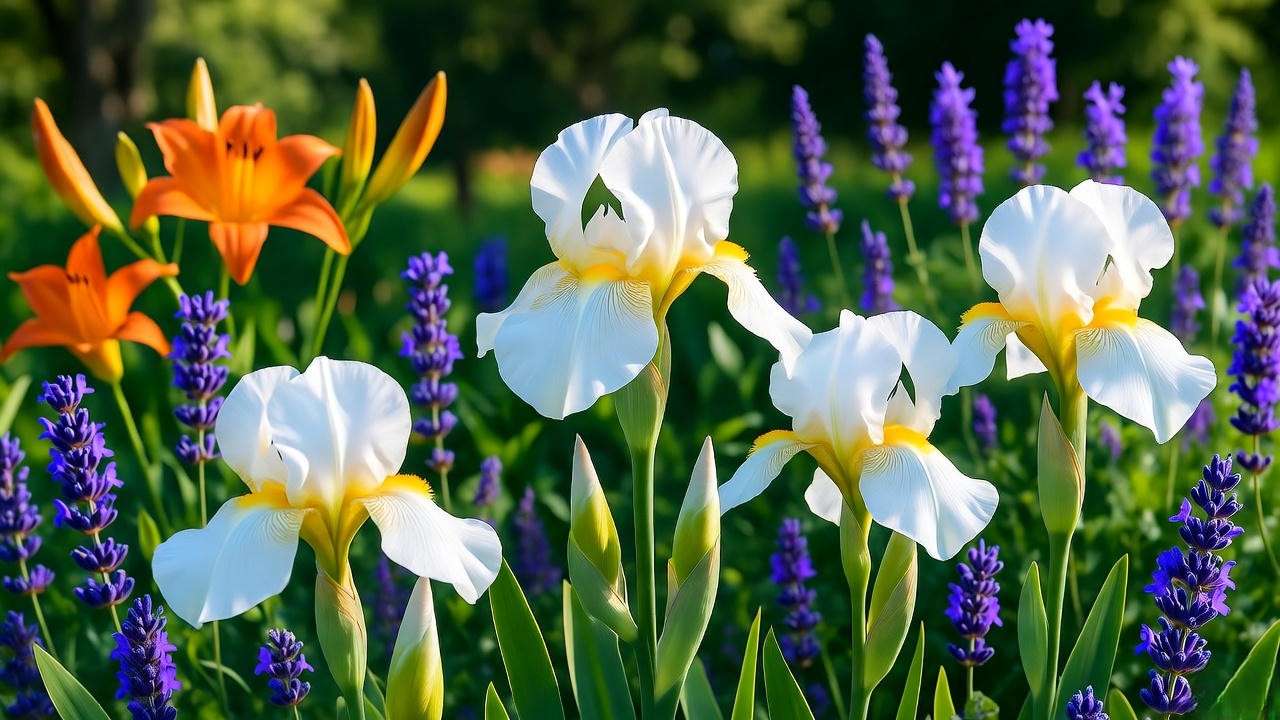
7.2 Landscaping Inspiration 🌳
White irises are versatile in garden design, serving as focal points or accents. Use bearded irises in formal borders along pathways for a structured look, or plant Siberian irises in clusters around ponds for a naturalistic effect. Create a monochromatic white garden by mixing irises with white roses and snowdrops for elegance. In rock gardens, Dutch irises add vertical interest among low-growing succulents. Visual Idea: A photo gallery showcasing white iris designs—from cottage gardens to modern landscapes—can inspire readers to experiment with their own layouts.
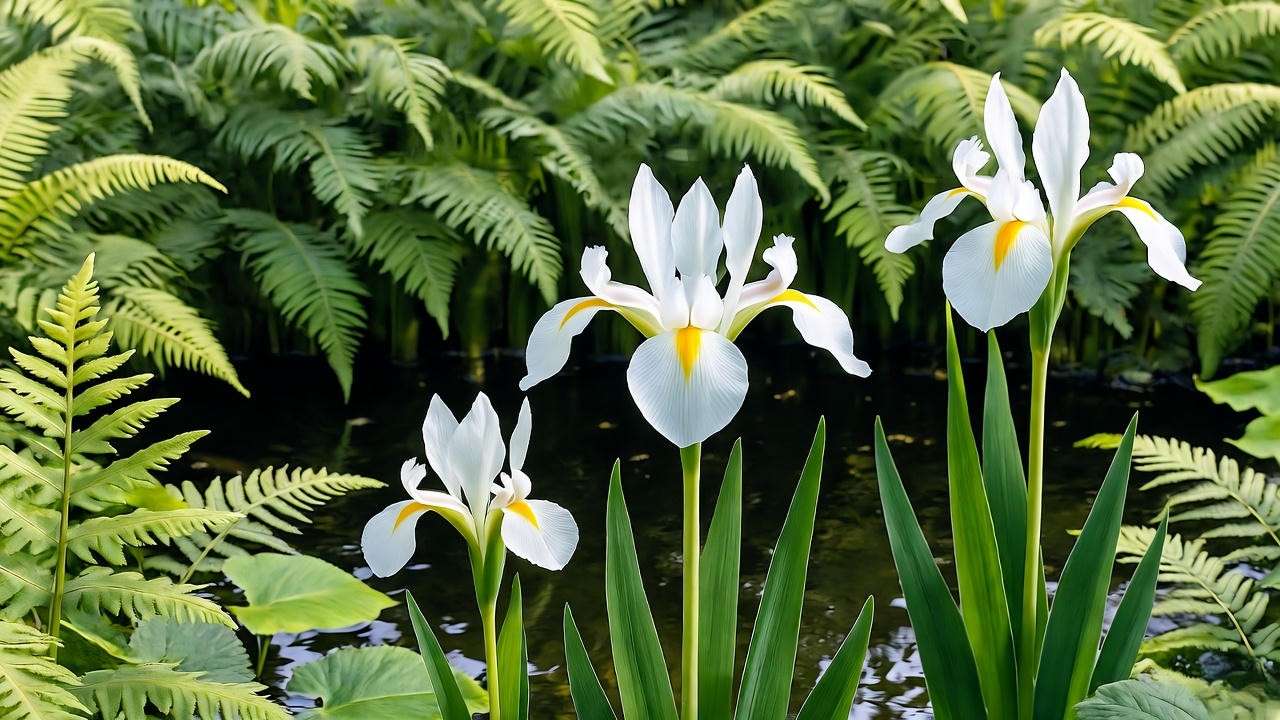
8. Troubleshooting Common Issues 🔧
Even with the best care, white iris plants may face challenges. Here’s a quick-reference guide to common problems and solutions:
- Yellowing Leaves: Often a sign of overwatering or nutrient deficiency. Check soil drainage and test for nitrogen or iron deficiencies. Adjust watering and apply a balanced fertilizer.
- No Blooms: Likely due to insufficient sunlight, overcrowding, or excessive nitrogen. Ensure 6+ hours of sun, divide rhizomes every 3–5 years, and use a phosphorus-rich fertilizer.
- Wilting Plants: Check for poor drainage, root rot, or iris borer damage. Improve soil aeration and inspect rhizomes for pests or soft spots.
- Brown Leaf Tips: Indicates heat stress or underwatering. Increase watering frequency during dry spells and provide shade in extreme heat.
Expert Advice: If issues persist, contact your local cooperative extension service for tailored advice based on your region’s conditions.
9. FAQs About White Iris Plant Care ❓
- Q1: How often should I water my white iris plant?
Water newly planted irises weekly, ensuring soil is moist but not soggy. Established plants need less frequent watering, about every 10–14 days, depending on rainfall. Siberian irises prefer consistently moist soil. - Q2: Can white irises grow in shade?
While bearded and Dutch irises require full sun for optimal blooming, Siberian irises tolerate partial shade. Avoid deep shade, as it reduces flowering and weakens plants. - Q3: Why are my iris leaves turning brown?
Brown leaves may indicate fungal leaf spot, overwatering, or natural dieback post-bloom. Remove affected foliage, improve drainage, and avoid overhead watering. - Q4: How do I store iris rhizomes over winter?
Dig up rhizomes after the first frost, trim foliage, and store in a cool, dry place in a breathable container with peat moss. Replant in spring or late summer. - Q5: Are white irises deer-resistant?
Yes, irises are generally deer-resistant due to their tough foliage and rhizomes. However, hungry deer may nibble in lean seasons, so monitor in deer-heavy areas.
10. Conclusion: Your Path to Stunning White Iris Blooms 🌟
Growing a stunning white iris plant is within reach for gardeners of all skill levels. By choosing the right variety, planting with care, and following seasonal maintenance tips, you’ll enjoy vibrant blooms that elevate your garden’s beauty. From preventing pests to designing elegant landscapes, this guide equips you with expert-backed strategies to succeed. Start your white iris journey today—plant a rhizome, nurture it with love, and watch your garden transform into a floral masterpiece. Share your iris-growing experiences in the comments or try a new variety this season! 🌼

